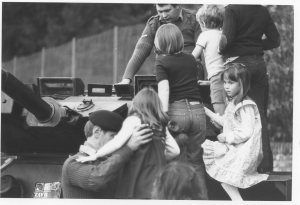Okay, this is not the blog post you were supposed to be reading today. That was going to be originally one on ‘sharp ideas: fuzzy concepts’ but after seeing Pop Goes the World at Tate I was going to blog about pop art.
You’ll get those in the future.
So why the suddent deviation from the plan (yes, I have a plan)? Well it was inspired by three things
1) Occasionally I put a roll of film through my Pentax, sort of for old time’s sake, which I was doing today
2) I was in my local Boots, The Chemist, when I saw that they were selling rolls of 35mm roll film, their own colour and Ilford monochrome
and
3) Watching tonight’s countryfile and seeing an item about photographer Jack Lowe and his project to photograph all the UK lifeboat stations using a vintage ambotype plate camera.
Which all got me thinking about using film (and plates), about analogue photography, indeed thinking about it to the point where I thought I may as well turn my thinking into a blog post. Analogue: What’s the Attraction?
There is, among audio engineers old enough to remember, a nostalgia for what is called ‘analogue warmth’, it’s hard to pin down exactly what this actually is but essentially it comes down to a desirable level of imperfection really. See this great article in Sound on Sound which also references digital imaging for some insights. Back in the days of the old Victor Blackman column in A.P. he always said medium format was better than 35mm as the resolution was better, and lens tests always involved blowing up images from the corner of 35mm frames to insane levels to see how much detail they had; my memory is that these were always of dockyards, maybe the office overlooked one, or maybe I’m imagining this. It was all about ‘sharp’ because sharp was good, the holy grail of a good image. But now we’ve got sharp, we’ve got sharp as never before, we’ve got sharp so sharp that if they weren’t photoshopped to within an inch of their lives even photos of top models would make their skins look less than perfect. Bizarrly, what do we do as part of our post-processing workflows pray tell? We apply sharpening, as though the bloody things weren’t already sharp as razors. Then we apply some extra contrast (I say ‘we’ because I do it too) because somehow contrast looks good, we’re used to contrast being on the high side. Hey, film never looked like that…
And, I suspect, that’s why many of use who remember film (and some snappers who don’t of course) are happy to go back to it. Because the photos look like photos. Take a look at this photo of mine, the year is 1979 and it’s from the first roll of film I put through my K1000 which was my first 35mm slr (I still have it, it still works). No idea who any of these people are because in 1979 it was okay to wander down to the local school fete and photograph kids with whom you had no connection, which in retrospect is quite alarming. It’s not a great photo, though I love the expression on the little girl’s face, but the blacks are nice and rich without needing too much contrast, and it’s sharp but not un-naturally so. It looks better on the print rather than this scan by the way, because it’s a totally analogue process from start to finish on the print.

Now I’m not going to type here and say that digital is rubbish, or even bad, because it’s not, it’s really good and I shoot most of my stuff on digital cameras now and I love doing that, but I love shooting analogue too. I think the issue is that everything that was said about the wonders of digital audio and imaging are perfectly true, that it would be sharp and clear; I remember a friend who heard one of the first CD players saying “the amazing thing was that there was no noise between the tracks!!!” That they’d be portable, and storage would be bigger and so we’d get more sound onto our players or more images onto our cameras. That with a digital camera we wouldn’t have to either do all that smelly stuff with chemicals and black out the bathroom, or wait for them to come back from the processor’s. All those things are true, and what made them such attractive concepts was that at the time they seemed to offer solutions to the things we disliked without us realising that a lot of those things were fundamental to what we enjoyed. We didn’t realise that actually, we could have too much sharpness and contrast, to much clarity and perfection.
Well put! Having been born into the pure analogue World of the 40’s, I am disappointed by the need shown by the modern generation to process the life out of both audio and image files to such an extent that they become merely sterile copies of the originals.
I too use digital formats for both audio recording, photography and film, also limited analogue photography with digital transfer, out of necessity, but my preference will always be for analogue with all its faults (and there are many), restrictions, duplication problems etc.
Just think on – analogue may have the last laugh and that is with its longevity and survivability. I wonder how many of today’s digital formats, cameras, recorders will be still readable/useable in 5….10…..15……20 years time. My old tapes are still playable after 46 years and I can stillstill work
LikeLike
Sorry hit the wrong button (another problem with digital)….still work the same tape recorder. My Grandfather’s photo prints and negatives are still ok and readable at 100 years, but I’m struggling to maintain and keep my digital archive alive and well and it’s only 15 years old!
All the best.
LikeLiked by 1 person